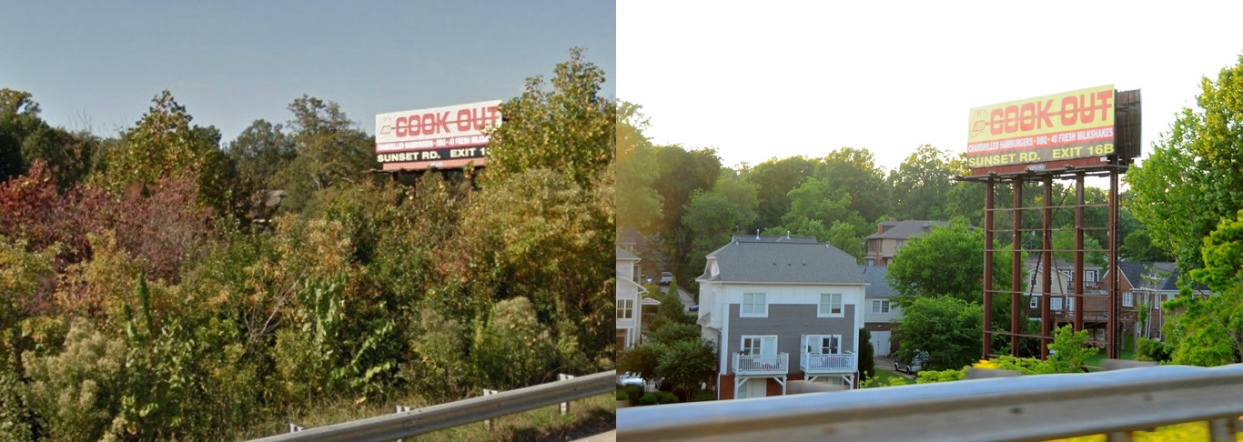It is the practice of several states, with acquiescence of of the Federal Highway Administration (FHWA), to permit outdoor advertising companies to cut, kill and remove publicly owned trees for the benefit of billboard visibility. A bill in the last Congress, H.R 5156, the “Protect Public Trees Act of 2018,” sponsored by Rep. Ted Poe (R-TX), was born in order to attempt to enact legally binding measures to abolish this practice.

The harsh effects of tree removal for billboard visibility can be seen in the image above, in Charlotte, North Carolina.
Scenic America has long pushed for an end to the practice of cutting, killing and removing public trees for billboard visibility purposes. Let’s look at where this practice started to become normalized.
The FHWA declared its stance and policy in a Memorandum signed by Associate Administrator Anthony Kane in 1990 stating that “to clear vegetation solely to improve the visibility of signs subject to removal under the Highway Beautification Administration Program is not environmentally responsive. It is Federal Highway Administration policy to be sensitive to environmental concerns, therefore such vegetation clearance can no longer be endorsed.”
Later, under pressure from the billboard lobby, FHWA claimed its 1990 Memorandum was simply a “statement of policy,” which states may choose to ignore. A study has shown that 62% of states currently allow trees and vegetation to be cut down, 20% of states have laws that are unclear as to the issue of cutting vegetation for billboard visibility and 10% do not allow the destruction of trees by the billboard industry. Four states do not permit billboards, therefore by default this issue does not apply to them, these states are Alaska, Hawaii, Maine and Vermont.
The billboard industry claims that the whole point of outdoor advertising is for it to be seen, including from adjacent roads. This “right to be seen” has been subject to a number of judicial decisions. The landmark decision in Adams Outdoor Advertising Limited Partnership v. City of Madison [1993] asserted that the right to visibility of private property from a public road is not a discernible right. Upon appeal to Supreme Court in 2018, despite arguing loss of economically beneficial use, as the billboard could not be seen, the Supreme Court threw out Adams’ claims.
The question as to whether the refusal to allow trees to be cut constitutes a compensable “taking” of the billboard owners’ property was settled far before 1993. As early as 1932, the New York Court of Appeals asserted its position in Perlmutter v. Greene [1932], talking about the State Superintendent of Public Works, stated that “he may plant shade trees along the road to give comfort to motorists and incidentally to improve the appearance of the highway…if trees interfere with the view of the adjacent property from the road, no right is interfered with.”
The argument that if removal trees was allowed, it would constitute an illegal gift of public property or an illegal relinquishment of right of way, was asserted in 1995. A Georgia Supreme Court found that it would constitute a gratuity to a private interest without providing any significant benefit to the community, therefore violating the state’s constitution.
Having discussed the legal disputes between states and outdoor billboard companies where this practice has not been allowed, there are still laws in certain states that have been created that not only benefit the outdoor advertising industries but also override the state Department of Transportation’s power. For example, in North Carolina a bill that came into effect in 2012 allowed billboard companies to cut vegetation around their signs up to 380 yards. The DOT in North Carolina have estimated that the value of trees lost in the next five years will amount to around $15 million.
H.R 5156 would have protected publicly owned trees from unnecessary destruction, maiming, or alteration for purposes of outdoor advertising visibility. The bill was written to include an exception allowing for the removal of public trees by state departments of transportation for public safety purposes.
Scenic America strongly opposes the practice of tree cutting around billboards and will continue to work with our friends in federal government to protect public trees permanently.
By Miguel José Escoriza, Scenic America Research Fellow